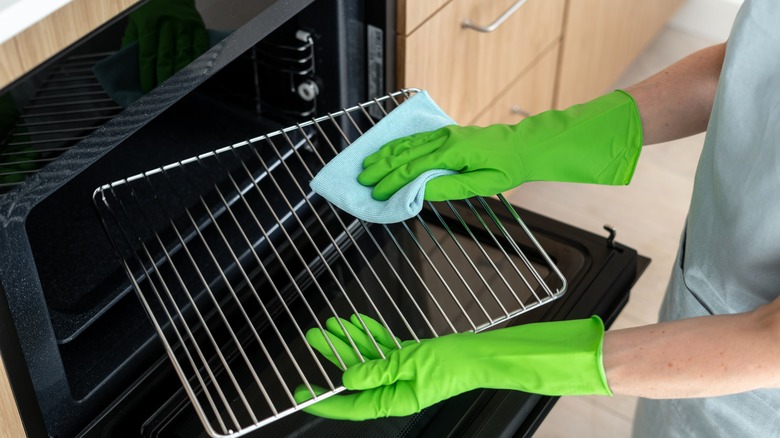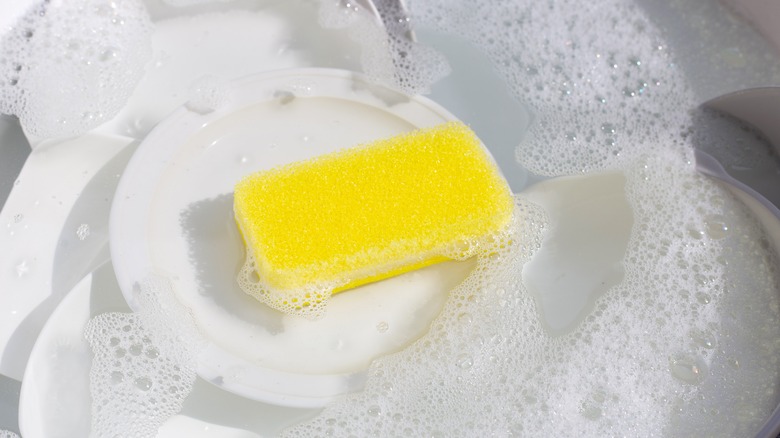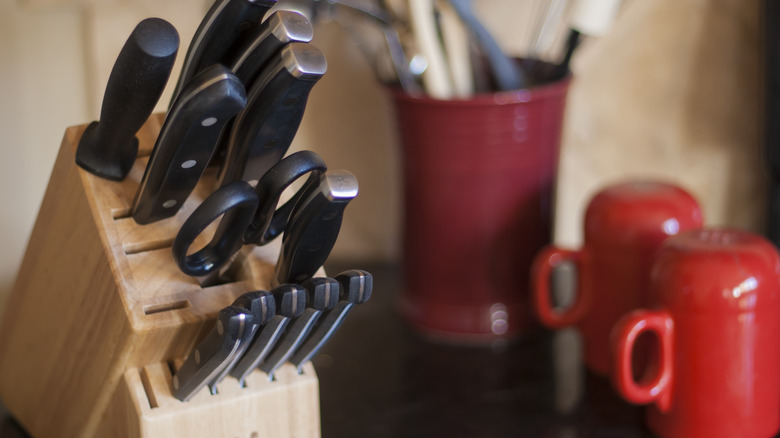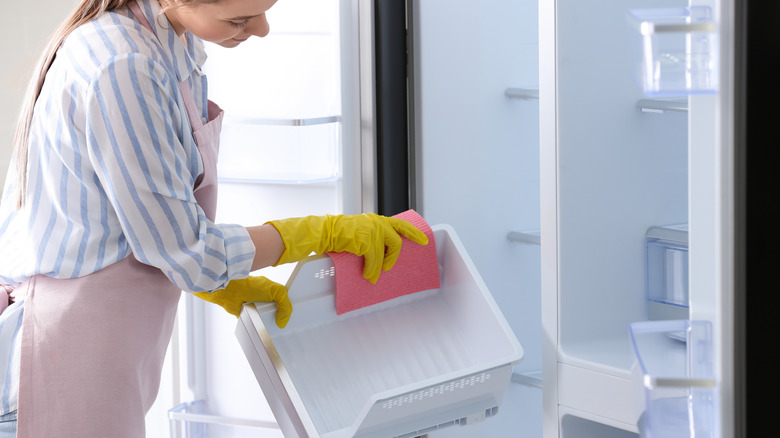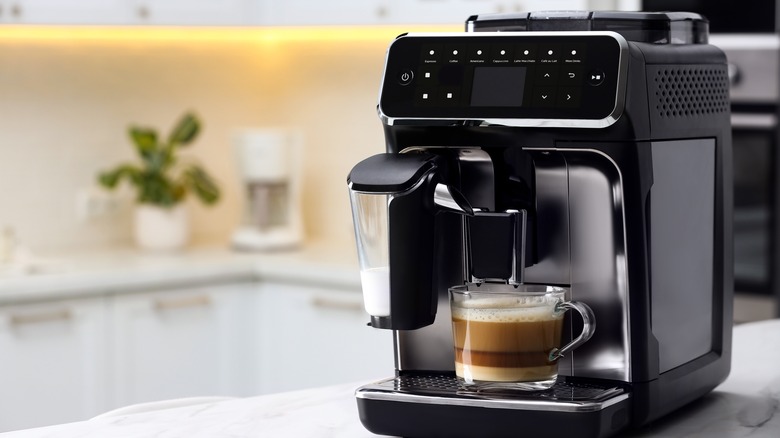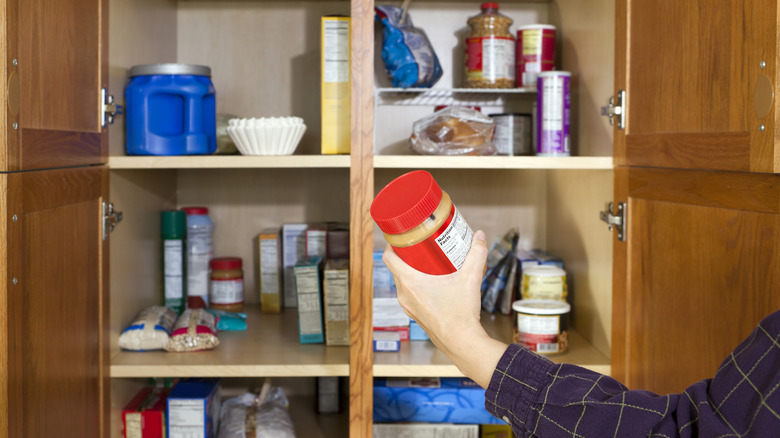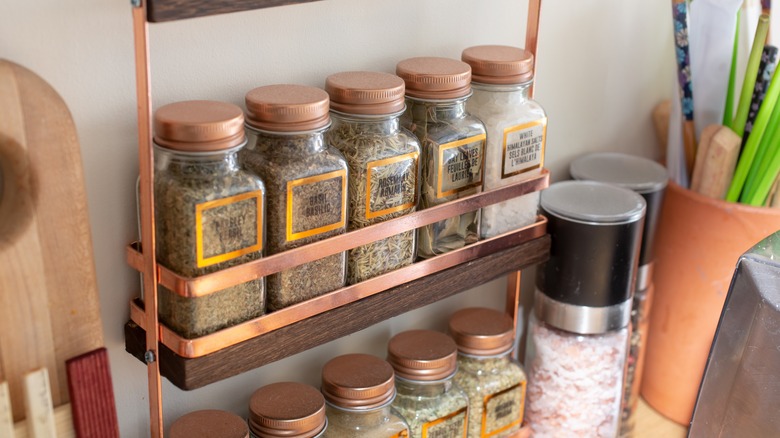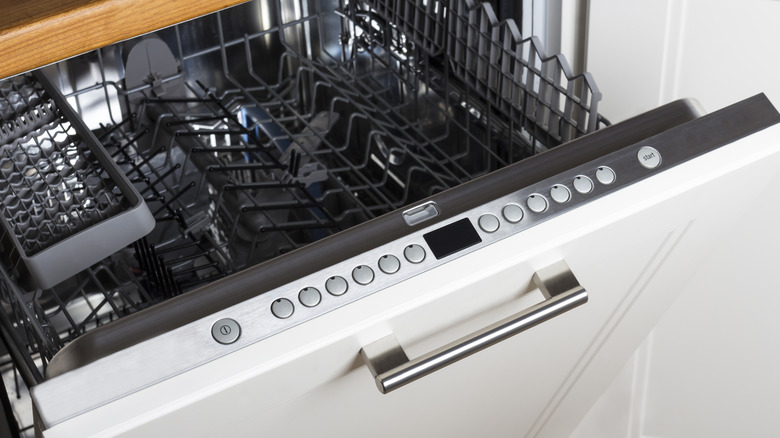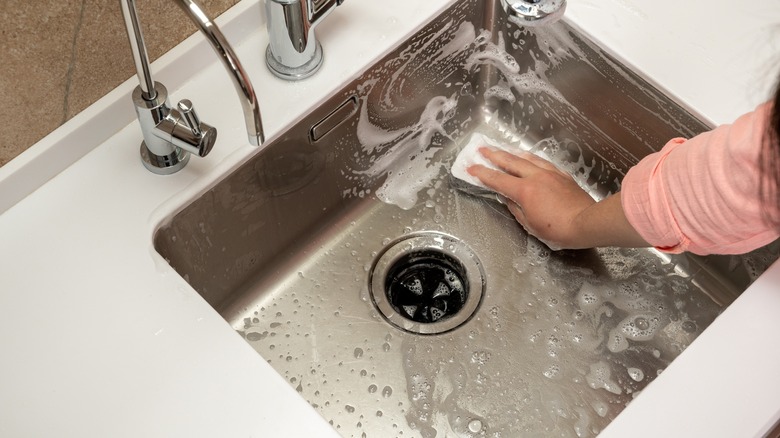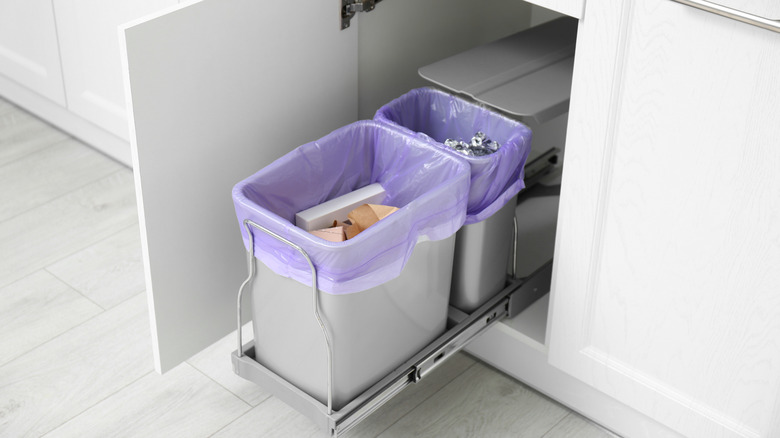13 Items In The Kitchen That You Should Clean More Often
We may receive a commission on purchases made from links.
The kitchen is supposed to be the warm, welcoming heart of the home, but this room is full of secrets. And not fun, espionage-type secrets, either: secret germs. Even if you think your kitchen is neat and tidy and the countertops look clean, a team of scientists armed with swabs could probably find some pretty gnarly bacteria lurking in multiple places throughout the room. Some of the germs that thrive in kitchen environments can pose serious health risks, especially to pregnant women and anyone who's medically vulnerable. And most people have no idea just how contaminated their appliances and other kitchen tools really are. (Yikes!)
Deep-cleaning your kitchen isn't just about making sure it looks picture-perfect at all times. Once you're aware of where the germiest spots are and how often they need to be cleaned and disinfected, you'll know exactly how to keep your kitchen safe and welcoming for all.
The oven
A dirty oven is a classic example of something that's usually out of sight and out of mind. Unless the door itself gets grimy, it's easy to neglect spilled food on the bottom of the oven and debris baked onto the grates. At least, you can ignore it right up until the moment when you go to pull dinner out of the oven and a cloud of smoke pours out too. Cooking in a dirty oven can also negatively affect the taste of your food and affect the appliance's finish. Most troubling of all, letting grease build up in a dirty oven can lead to a kitchen fire.
Manufacturers generally recommend that you deep-clean your oven at least every three months or more frequently if they're used regularly. Always start with a cold oven. Pull the racks out, soak them in hot soapy water, and scrub them clean with a rag or brush. Cleaning the inside of the oven itself can be done by spreading a paste of baking soda and water all over the walls. Let it sit for 20 minutes, spray it down with vinegar or lemon juice, and use a damp cloth to scrub everything out. You can generally use the baking soda paste and vinegar combo to clean an oven's glass window, too; check the manual for your model to get specific cleaning advice that won't damage your oven.
Sponges
It helps to not think too closely about what might be growing in the warm, wet, porous spaces of your kitchen sponges. They're a notorious breeding ground for bacteria including salmonella, listeria, E. coli, and more. Considering you use sponges to clean things that are used for food prep, we don't have to tell you that's ... not great!
Sponges should generally be replaced or cleaned at least once a week. Sponges should also be put aside for cleaning after they've been used to clean up juices from raw meat or seafood or raw eggs. There are a few generally accepted ways to clean kitchen sponges, with varying degrees of effectiveness. Scientists from the Agricultural Research Service studied five sponge cleaning methods and found two that killed more than 99.9% of bacteria: microwaving sponges for one minute, and running them through a dishwasher with a drying cycle. The researchers found that dirty sponges soaked in bleach, lemon juice, or water still contained enough bacteria to potentially sicken someone. But killing bacteria in the microwave or dishwasher won't keep sponges clean forever. Buy them in bulk so you can easily replace a sponge that's starting to look a little worse for wear.
Dishcloths and kitchen towels
Like sponges, kitchen towels and dishcloths need to be cleaned more frequently than most people probably realize. Although they might not get as wet as sponges, kitchen linens can still harbor bacteria, not to mention plain old dirt and food debris. You definitely don't want to wipe down your counters or clean your hands on a piece of fabric that's tainted with raw chicken or someone's cold germs.
Ideally, you'd pull out clean kitchen linens every day. If that's not realistic for your busy life, aim to replace them with clean versions at least once a week, but make an exception for towels or dishcloths that make contact with raw poultry, raw seafood, or other items that are known to cause foodborne illnesses. These need to be cleaned right away. Wash kitchen linens with detergent and the hottest water your washing machine has. Dry them on high heat until they're completely dry. Don't forget to include cloth napkins and washable fabric placemats when you're cleaning kitchen linens!
The knife block
Just because you put knives away clean doesn't mean they come back out of the knife block clean. All those neat little slots that let your knives slip inside are also a perfect fit for crumbs, dust, and other debris. And because a knife block is something most people probably clean rarely (if ever), there's a good chance a lot of that gunk is accumulated inside yours right now.
A knife block should be cleaned much more frequently than you might expect. Or at least, so say the cooking experts at America's Test Kitchen, who recommend washing a wooden knife block every four to six weeks. Scrubbing into the knife slots with a bottle brush should allow you to dislodge any debris stuck down there. Use the brush with hot, soapy water to clean inside every nook and cranny. Then, wipe down all the exterior surfaces of the block with a sponge and more hot, soapy water. Wipe down the knife block with a dry cloth and let it air dry completely before replacing the knives. This strategy should do the trick for most knife block models. Some versions have dishwasher-friendly components (like magnetized versions or a bamboo knife block with removable bristles) that make cleaning even easier. No matter what kind of knife block you have, it's a good idea to clean your knives before putting them back; maybe check if you need to sharpen your knives while you're at it?
The fridge
A dirty fridge isn't ideal in any household, but did you know it could actually be a significant safety risk if anyone in your household is pregnant? Apart from holding onto funky smells that could make your food taste bad, an unclean refrigerator may also harbor listeria. These bacteria may contaminate cheese and other dairy products, as well as ready-to-eat items such as deli salads, fresh-cut fruit, and other things meant to be eaten raw. Listeria bacteria can survive in the cold environment of your fridge, and anyone who eats contaminated food could become sick with listeriosis. It's typically pretty mild but can cause complications for pregnant people and prove deadly for their babies. Listeriosis can also be fatal for infants, elderly people, and anyone with a weakened immune system.
Suffice it to say, keeping your fridge clean is important! The general wisdom from manufacturers says to deep-clean your fridge every three months or so. When deep-cleaning, pull out all the food and all removable drawers and shelves. Wash these plastic or glass components by hand with soapy water. Wipe down the interior surfaces of the refrigerator with a soapy wet cloth or a cloth dipped in a solution of vinegar and water, followed by a clean damp cloth. In between deep cleanings, make it a habit to clean up any spills or leaks as soon as they happen to prevent listeria from spreading.
The coffee maker
Here's a deeply unfun fact for those of who always start the day by turning on the coffee maker: Its water reservoir may be one of the dirtiest places in your home. In one study done by the National Sanitation Foundation, researchers went into 22 volunteers' homes and swabbed 30 common household items and surfaces. They found yeast and mold in 50% of the coffee maker water reservoirs they tested. Granted, the study was done in 2011, so they were probably testing different models of coffee makers than the ones many of us use today. But that won't provide much comfort when you're watching your Keurig heat up and wondering what else is brewing in there besides your next cup. Keeping your coffee maker clean is also important for quality control purposes. A dirty machine makes funky-tasting coffee, and older models especially can be stopped up and slowed down by gunk.
If your coffee maker has a removable water reservoir, you may want to give this piece a scrub with hot, soapy water once a week or so. The best practice is dismantling and deep-cleaning your entire coffee maker every three to six months, or even more frequently if it gets daily use. Descaling the machine to remove mineral deposits is part of the cleaning process. Typically this is as simple as running a mixture of vinegar and water through the machine or using a commercially sold descaling solution. But there's variation in how various models can and should be washed, so check the manual for yours before proceeding.
Pantry shelves
Assuming you're not trying to start a thriving colony of pantry moths in your kitchen, your pantry shelves might need a little more regular attention. Spilled food and unsealed containers attract bugs and other unwelcome critters like mice. It doesn't take long for a full infestation to break out, especially if the food source is near the back of the pantry or on the tallest or lowest shelves. Cleaning out the pantry on a routine basis also allows you to discard expired or spoiled food, reminds you to use up things that are nearing their expiration date, and allows you to reorganize the pantry so its layout works for you.
Ideally, clean out the pantry a few times throughout the year — or at the very least, once a year. Pull all the food out so you can wipe down dusty containers, check expiration dates, and look for any signs of mold growth or insect activity. Brush debris off the empty shelves, then wipe them down with a damp soapy cloth.
Spice containers and oil bottles
This one is common sense, and yet it's something most of us probably don't think about. Of course salt shakers, pepper grinders, and other spice containers would be some of the germiest places in the kitchen. Everyone who prepares food in your house grabs these items during food prep and dining alike, transferring all kinds of bacteria and food debris onto them in the process. One study published in the Journal of Food Protection found that spice containers are a huge risk for cross-contamination. (Researchers tracked hundreds of participants through the process of cooking a turkey burger and found that nearly half of the spice containers the participants used were contaminated with bacteria by the end of the experiment.)
Spice containers, plus frequently used countertop items like salt and pepper shakers and olive oil bottles, should be cleaned often — like after every time you touch them while cooking raw meat. Obviously, it's imperative to do this carefully so as not to taint seasonings and other edible ingredients with harmful cleaners. One of the study's researchers advised that home cooks wipe down containers with a soapy cloth, followed by a spritz of a kitchen disinfectant spray. Just make sure containers are totally sealed first, or transfer their contents into a second clean container while you clean the original one.
The dishwasher
Just because the inside of the dishwasher looks sparklingly clean at the end of a cycle doesn't mean it really is clean. Over time, gunk and food debris build up in the filter and crevices. Mold growth thrives in warm, dark, damp environments, which pretty much describes the inside of your dishwasher. (This is also why washing machines need more frequent cleaning than many people realize.) Routine cleaning prevents odors from developing and keeps the dishwasher working efficiently. You should notice when your dishwasher needs to be cleaned because it'll start to smell and become less effective at cleaning dishes.
Make a habit of scanning the bottom of the dishwasher after each load so you can remove any visible debris. Aim to do deep cleaning once a month. Depending on how grimy your dishwasher is and what kind of cleaning products you have on hand, there are a few ways to do it. One strategy that Whirlpool recommends involves placing a glass measuring cup or other dishwasher-safe container on the bottom rack of the empty dishwasher, filled with 2 cups of white vinegar. Run the dishwasher on its normal cycle (don't use the heat dry setting) with nothing but the vinegar inside. Next, spread 1 cup of baking soda across the bottom of the dishwasher and run the machine again with hot water. Alternatively, you can buy some dishwasher cleaner and follow the directions on the package. Either way, don't forget to check the filter for food debris and other gunk; refer to the manual to figure out how to clean your filter — it usually involves scrubbing it with a small brush in hot, soapy water.
The sink
Let's not mince words here ... your kitchen sink is probably extremely gross at this very moment. Even if it's empty of dishes and looks pretty clean to the naked eye, all kinds of nasty bacteria and food debris can collect in the kitchen sink over the course of just one day. The National Sanitation Foundation's study — the same one that exposed the uncleanliness of your coffee machine — found that the sink was the second germiest place in the home, after sponges and dish rags. Preventing cross-contamination and keeping funky odors at bay requires frequent cleaning.
The USDA actually recommends following a two-step cleaning process every time you wash or prepare food. First, clean the kitchen sink with warm, soapy water and paper towels. (Even if you're dedicated to minimizing waste and using reusable products whenever possible, disposable paper towels are the right choice for preventing cross-contamination here.) Once it's clean and dry, spritz the sink with a sanitizing solution and dry it with paper towels. The USDA recommends using a ratio of 1 tablespoon of liquid bleach to 1 gallon of water. That breaks down to 1/16 tablespoon of bleach per cup of water. Store-bought sanitizing and disinfectant sprays are another option. Just make sure to follow package directions.
Drawer handles, cabinet pulls, knobs, and light switches
How many people have touched your kitchen light switches and door knobs since the last time they were cleaned and disinfected? Trick question: You probably don't know the last time these surfaces were cleaned. Knobs, handles, and switches are all high-touch areas that most of us probably neglect when we clean our kitchens. (There was a brief period early in the pandemic when it seemed like we were all disinfecting our doorknobs daily, but — like baking our own sourdough — that turned out to be a temporary habit.)
How often should you clean these surfaces? The CDC (somewhat vaguely) says to clean them "regularly," especially after you have visitors in your home. To be safe, why not add this task to your end-of-day kitchen cleanup routine? Wiping them with a soapy cloth should be sufficient for daily cleaning. Disinfect switches, handles, and knobs after someone in your home has been sick. To do it, start by cleaning handles and knobs with hot, soapy water and follow with a disinfecting spray or a diluted bleach solution (4 teaspoons of bleach per quart of water). Stick to the spray for switches so you don't get electrocuted. After spraying, let the disinfecting solution sit for at least a minute before wiping down the area.
Trash cans
When your kitchen trash gets grimy and smelly, everyone who enters your kitchen can tell. Unless you're hosting Oscar the Grouch for brunch and want him to feel at home, you probably want to keep the "eau de old garbage" at bay. That means being diligent about cleaning the can often. Like, every time you empty it.
Cleaning your kitchen trash can doesn't necessarily mean taking it outdoors, bleaching it, and hosing it down. Spraying the inside and outside of the empty can with disinfecting cleaner or your favorite all-purpose cleaner should be sufficient for routine cleaning. Let the cleaner sit for a few minutes and follow with a clean cloth or paper towels to scrub the can dry. Don't forget the inside of the lid — in fact, you might want to give this area an extra scrub with a soapy cloth or cleaning wipe to get rid of any debris stuck there.
Reusable bags
Reusable bags certainly have some advantages over single-use plastic bags, but cleanliness isn't one of them. Any food that spilled or leaked into your bag during your last grocery store run could still be lingering in the bag when you load today's groceries into it. Bacteria like E. coli and salmonella could thrive in the warm, dark environment of a folded-up reusable bag. Plus, think about all the germy surfaces that come into contact with the exterior and handles of these bags: the inside of the shopping cart, the conveyor belt at the grocery store checkout, the trunk of your car, etc.
The best practice is to wash your reusable bags after every shopping trip. Definitely make a point to clean bags immediately after they've been used to transport things like raw meat or seafood, or whenever they're visibly dirty. For cloth bags, machine washing with detergent should be fine. Plasticky or insulated bags can be hand-washed with soap and warm water and allowed to air dry or simply cleaned with a wipe.


